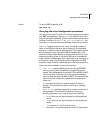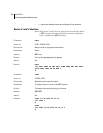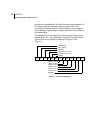
CHAPTER 4
Using terminal commands
37
DESCRIPTION Returns data stored for a certain device.
PARAMETER The ID of the device for which the data is requested and the date/
time (in the standard format) the data was stored. If missing, then it
refers to the data of the local device.
RETURNS A data block.
REMARKS GET only. If you don’t include the date/time parameter, the latest
data is returned. If you include the date/time parameter, the date
and time closest to, but later than, the given date/time is returned.
REMOTE Yes, for a GET on the A720B and A723, but only one frame at a
time. If you are using a terminal window for the A720, you cannot
issue the DATA command remotely. If you are using a terminal win-
dow for the A720B, you can issue a DATA command for an A720 or
A723 RTU, but you cannot issue the command for the A720B
receiver. In other words, the base station can issue a remote com-
mand for an RTU, but it cannot issue such a command for itself.
The A720 RTU can issue the command only for itself, and only
locally, while the A723 RTU can also issue remote data commands.
EXAMPLE DATA 5666 12/12/1998 12:12:12
193 DATA b1 b2 b3 ... bn 0
#
The data block returned will typically contain a number of data
frames (telegrams). The structure of a block is as follows:
dd mm yyyy hh mm ss si ft d1 d2 ... dn dd mm yyyy
... dn cs
where:
• dd mm yyyy is the date
• hh mm ss is the time
• si is the size of the frame
• ft is the frame type (38 for addIT devices)
• d1 d2 ... dn are the data values (the frame content)
• cs is a 16-bit checksum obtained by summing the bytes and
discarding the carries over 0xFFFF
The A720 devices respond with a type 38 data frame, while the
A723 may respond with type 38 or type 39, depending on the CM
flag (see also “CM” on page 34). The most important difference


















